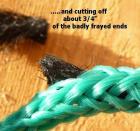
Make safety a top priority
ALL of our hollow braided 3/8” polypropylene ski lines have a working load of approx. 1000 lbs,
and a break strength of almost 2000 lbs at 20% elongation
 width= />
width= />
They also have a generous saturation of quality mineral oil to keep the rope soft and supple, and to resist drying out and becoming brittle. It also adds a nice shine.
 width= />
width= />
The nature of ropes is that they wear out. Possibly nothing in skiing is subject to more stress or abuse than a ski rope. And, yet it is the one item that affects your safety the most.
Most skiers take a rope for granted, and expect more from a rope than is realistic. Just because a rope has not broken, does not mean it is still SAFE to use. Ultraviolet rays weaken ropes tremendously. Constant exposure to sunlight, and endlessly getting wet and drying out, will eventually weaken the fibers to less than 50% of their original strength. Some colors will also fail before others. Bright colors like yellow and orange will be the first to go, and clear rope is the strongest.
Some skiers have exerted over 1000 lbs of force on a rope during a cut. If you allow a rope to be used too long, it may break at the worst possible time. Your safety is worth more than any ski rope, so replace worn ropes or sections BEFORE they have a chance to break!
6 ways to extend the life of your rope
1) ONLY use quality 3/8" ropes with mineral oil, & ropes that have removable sections, and replace damaged loops immediately. Using marginal ropes is unsafe and unwise.
2) Before use, inspect closely for knots, frayed sections, etc. Immediately after use, coil the rope directly from the water and remove from sunlight. Ideally, store the rope in a closed cooler of cold water. As long as rope STAYS submerged in water, it remains like new. (After 10 years, our portable slalom course mainlines were like new.)
3) DON'T drag ropes up onto a rocky beach, through the sand, across wooden docks, etc. and DON'T leave the rope lying in the boat, where sandy feet or shoes can walk over it, and DON'T use ropes to tie up your boat! Rubbing against docks ruins a rope in no time.
4) DON'T ever use a rope with a knot. Knots weaken a rope in that spot by about 50%.
5) REMOVE all knots by laying the rope out on a smooth, hard surface, and begin slowly and softly pounding the knot with a hammer as you rotate the knot to impact it from all angles. Be patient. It may take some time, but eventually, the knot will loosen up enough to remove it.
6) TRIM the tails....Over time, the cut ends of the "tails" will emerge from the rope.
These act as a saw, and during every pull, as the rope is stretched and released, the rough, frayed edges will rub against the hollow interior of the line. This is the # 1 cause of a rope breaking. Using an awl, pull out the ends, and cut off about 3/4" of this dried out rope. This will help increase the life of the rope.
 width= />
width= />
 width= />
width= />
 width= />
width= />
 width= />
width= />